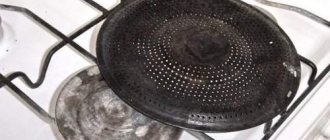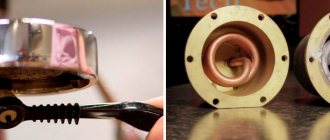Before we dive in, let's talk a little about what a pannarello attachment is. When steaming milk using a regular steam wand, the steam wand is positioned just below the surface of the milk. When the positioning is correct, the steam sucks some of the milk from the surrounding air along with it.
So the steam entering the milk is actually a mixture of steam and air. This produces tiny bubbles that create milk foam; key element for steamed milk. For all this to happen, the nozzle must be precisely positioned and the steam must be at a high enough pressure.
This creates a problem on home espresso machines. Firstly, because many users do not have the necessary skills, and secondly, home coffee machines are usually not capable of producing enough steam.
Manufacturers have solved these problems by equipping their machines with Panarello steam nozzles. Although there are many different designs, Panarellos work on the same general principle. They all use some kind of mechanism to automatically mix air into steam. This way, the user doesn't have to worry about precise positioning, and steam pressure isn't that big of an issue.
It's quite possible that your car has a pannarello, even if you've never heard the term. Most home espresso makers don't use the term "panarello", probably because no one will know what it is. Rather, most manufacturers have come up with their own name for their steam nozzle. Such as auto-foaming agents, foam boosters, jet foaming agents and so on.
So how do you know if your machine has a panarello or a regular steam wand? A regular steam wand is a simple tube with a cap that has one or more holes in it. Panarello, on the other hand, will have some sort of attachment attached to the steam wand. If your steam wand has any type of attachment on the end, it is most likely a panarello.
First we need to discuss frothing milk a little: We want a thick, smooth, silky consistency, almost like thick paint, for that creamy texture in the milk. This is achieved through a constant supply of steam, which is easy if you are using a commercial machine equipped with a large boiler capable of producing large amounts of steam. A combination of air and steam and a little practice with swirling the milk in the jug and some tamping at the bottom to pop the big bubbles will get you there.
What is pannarello?
First, let's tell you in more detail what a Panarello manual cappuccino maker is.
Many devices for making coffee have a special nozzle, most often made of stainless steel, less often of plastic. The nozzle is fixed to the steam supply hole and has a tip split into several holes. It is thanks to these holes that steam effectively and quickly whips milk to the consistency of dense foam.
Important! The more holes at the end of the nozzle, the better.
Making several cups of cappuccino
If you have guests or you just have a large family, then the previous method is quite problematic. Substituting each cup of milk under steam and then under coffee is a rather long process. It can be avoided using a simple method. Take a large glass, preferably a metal one made of stainless steel; the pros call it a pitcher.
A milk pitcher is a special metal container with a narrowed spout for mechanically foaming milk using a panarello.
Fill the pitcher halfway with milk and do everything the same as in the previous method. But already with a large volume of milk. Then just have time to press coffee preparation and add milk to taste. If you want, add milk to the cup before making coffee, or while making coffee, or after. As you please. Experiment and you will get a delicious cappuccino, no worse than in a cafe.
What is the pannarello attachment for?
Unlike automatic cappuccino makers built into coffee machines, which require a jug into which milk is poured, devices with a Panarello nozzle whip up milk foam in a pitcher or any other suitable container, which should simply be brought to the steam supply device. This design not only froths milk in less than half a minute, but also simultaneously heats it to the desired temperature.
Most professional baristas prefer the Panarello attachment to other cappuccino makers, as it allows complete control of the frothing process and regulation of the density, volume and temperature of the milk froth.
How to use a cappuccino maker?
A home cappuccino maker is, of course, not an essential item. But if you like to drink coffee in the morning, especially cappuccino with delicate milk foam, then this is exactly what you need to make your morning coffee ritual even more enjoyable and ensure a good mood for the whole day.
Manual cappuccino maker - what is it?
A manual cappuccino maker is an element of a coffee machine designed to heat and emulsify (whip into foam) milk. It is thanks to this functional detail that we obtain milk foam for preparing classic espresso-based drinks: cappuccino, latte, etc.
How to froth milk using a manual cappuccino maker, what are its main differences from an automatic one and which one is more suitable for home use - you will find the answers to these questions below.
Operating principle of a manual cappuccino maker (panarello)
A cappuccino maker is a special attachment that is attached to the steam wand of a coffee machine. Steam for frothing milk is generated in a separate boiler or using a separate heating element as part of the main boiler (depending on the model of the coffee machine). Pressurized steam is then released into the steam wand.
The container for frothing milk is usually a pitcher - a special jug. It can be steel, porcelain or even plastic. But the most popular among baristas are stainless steel pitchers. Why - read below!
Almost all modern models of carob coffee makers and automatic coffee machines are equipped with a cappuccino maker.
Automatic cappuccino maker
There are also coffee machines with automatic cappuccino makers. Here your role in frothing the milk will be minimal. This type of cappuccino maker has a tube that is lowered into a container with milk, from where it is drawn into the cappuccino maker due to the pressure difference in the chambers of the device. The finished milk foam is served directly into a cup or glass with the future cappuccino or latte.
How to froth milk with a manual cappuccino maker
To prepare fluffy and thick milk foam for cappuccino, you will need a panarello nozzle, cold milk with a fat content of at least 3.2% and a special whipping jug - pitcher. When purchasing a pitcher, give preference to a container made of stainless steel.
- Pour milk into the pitcher (a little more than the volume that you will add to the future drink)
- Turn on steam mode
- Place the milk pitcher under the cappuccino maker nozzle and plunge it into the liquid at a slight angle. Do not immerse too deep, 5-7 mm is the optimal depth
- The milk frother should create a funnel in the milk.
- Adjust the position of the pitcher so that the process of disappearing large bubbles begins. Our goal is smooth foam, similar to melted ice cream.
- Once the milk has increased significantly in volume (approximately 2x for cappuccino and 1.5x for latte), immerse the nozzle deeper to warm the milk
- Do not overheat the milk, otherwise you risk getting a cappuccino or latte with an unpleasant bitter taste.
How to determine the desired milk temperature?
Time to reveal the secret of the stainless steel pitcher. The optimal milk temperature for making latte or cappuccino is 60-70°C. Hotter milk will cause an unpleasant aftertaste, and at 80°C it will already begin to boil. If you don't have a special thermometer that will show the current temperature, you will have to trust your own feelings.
So, the milk has reached the desired temperature when the steel pitcher heats up to such an extent that it is impossible to touch it for more than 2 seconds.
Useful tips from the barista
- If there are a few large bubbles remaining on the surface of the frothed milk, tap the bottom of the jug on the counter several times, rocking the jug in a circular motion.
- Do not fill the pitcher more than half full with milk.
- Once you have prepared the milk foam, immediately pour it into the cup, otherwise the texture of the foam will be destroyed.
- Clean the cappuccino maker after each use, as it is an excellent environment for the growth of lactic bacteria. To do this, simply fill the pitcher with water and start the steam generator, just like when frothing milk.
Which cappuccino maker is better: manual or automatic?
In order to decide which coffee machine model is right for you, answer a few questions regarding your coffee preferences.
- Do you drink more than 3 cups of cappuccino a day?
- Are you choosing a coffee machine for an office or restaurant?
- Are you interested in minimizing the time spent preparing coffee?
- Have you already tried frothing milk with a manual cappuccino maker and did not find a common language with it?
If the answers are positive, the best choice for you will be a coffee machine with an automatic cappuccino maker. Consistent quality of drinks, minimum effort, always delicious latte or cappuccino.
Advantages of a coffee machine with a manual cappuccino maker (panarello):
- Significant savings - coffee machines with a manual cappuccino maker are cheaper.
- Ideal for mastering latte art.
- A coffee machine with a panarello gives more opportunities for coffee experiments and independent creativity.
Milk frothers
In addition, the Kofe.ru online store offers an excellent alternative to both cappuccino makers - separate cappuccino makers or milk frothers. This cappuccino maker is suitable for those coffee lovers who prepare their drink not in an espresso machine, but in a different way, but also love lattes and cappuccinos.
Milk frothers differ in design. The first group is a stationary device that has its own whipping pitcher . Such devices will help you get hot milk, cold milk and hot milk foam. The milk is whipped by a whisk powered by an electric motor.
The second group is devices like a submersible mixer that froth milk directly in a cup. A small spring-ring whisk vibrates and moves, whipping the milk into foam. They are called creamer blenders or simply creamers.
The third group of mechanical foamers are devices that are driven by muscular force.
Electric milk frothers are an ideal choice for those who do not want to master the science of frothing milk themselves, monitor the temperature, and achieve dense, uniform foam. All you have to do is fill the pitcher with the required amount of milk and press the button. After a few seconds, cold or hot milk foam is ready!
Which cappuccino maker would you choose?
What is the difference between a cappuccino maker and a panarello?
Many coffee machines have built-in cappuccino makers of various shapes and types. How do they differ from devices with a manual cappuccino maker? We will talk about this further.
- First of all, they differ in the principle of operation. If the built-in cappuccino maker takes a portion of milk and froths it inside the coffee machine, in order to then pour the finished foam directly into a cup of coffee, then the panarello allows you to froth the milk using steam in an external container, which you simply bring to the manual cappuccino maker.
- Secondly, coffee machines with a built-in cappuccino maker and with a panarello differ greatly in price. A coffee machine with an automatic cappuccino maker can be very expensive. Devices with a manual cappuccino maker are usually much cheaper.
- Thirdly, many superautomatic coffee machines with a built-in cappuccino maker operate almost silently; this cannot be said about using a panarello.
Differences from a cappuccino maker
If we consider the functioning of panarellas, then we can come to the conclusion that they differ significantly from an automatic cappuccino maker.
The problem and disappointment is that espresso makers are smaller for home use. Boilers are small (about 120 ml capacity, compared to 2 liters for commercial machines and above) and need to heat water for espresso as well as produce steam. Enter Panarello, a kind of trickster who compensates for the lack of steam energy. These Panarellos are designed in such a way that some air is introduced along with the steam to aid the foaming process and create microfoam. The Panarello can be a simple tube sleeve inserted over the steam wand with a micro-hole for air intake, or the steam wand itself has a small component built in with many micro-holes designed for the same purpose.
Which coffee machine should you choose?
If you are faced with a choice of which coffee machine to buy for a coffee shop or for home use - with a built-in cappuccino maker or with a panarello - then choose based on the number of cups you will prepare per day.
- If this is a coffee shop, then the traffic will be high, and you will need to brew a lot of coffee with a cup. Then it is better to choose a coffee machine with a built-in cappuccino maker. It will not only allow you to prepare drinks with the same amount and consistency of foam, but will also simplify the barista’s task, since he will not have to stand at the machine while the coffee is being prepared. In addition, the milk, constantly circulating through the tubes inside the cappuccino maker, will not have time to dry out due to the large flow of people. Such a car can be washed only once a day - at the end of the shift.
- If you are choosing a cappuccino maker for your home, it is best to choose a model with a panarello. Firstly, it is very practical - the milk will not dry out, even if you do not wash the device every day or do not use it very regularly. All you need to do is wipe the nozzle with a cloth after use or “foam” plain water to clean the nozzle. In addition, thanks to the panarello, you can regulate the density and amount of foam yourself, making it exactly the way you like it.
Drink preparation steps
In the machine:
- The desired mode is selected on the device.
- Milk is poured into a special container and placed on a nozzle that will suck it into the cappuccino maker.
- The heated cup is placed under the nozzle through which the finished product is poured.
In semi-automatic:
- Warm the cup until it is warm.
- Fill the holder with ground coffee and, placing the press at an angle of 90 degrees, press it.
- Place the holder on the post and turn on the machine.
- Fill a warm cup with espresso.
- Warm up the steamer and turn on the steam for a few seconds, moving the spout of the device to the side. This manipulation will help get rid of the water formed in the cappuccino maker.
- Fill a tall 300 ml milk jug ¾ full and place it under the switched on steam tap at an angle of 45 degrees, then the bubbling will occur more intensely. First, the device should be immersed in milk by 3 cm. Then its spout should be kept at the very edge, otherwise the dense foam required in the recipe will not be obtained.
To obtain a more airy foam, you should periodically change the depth of immersion of the cappuccino maker in the milk and supply steam under high pressure. In addition, you should take a product with a fat content of no more than 1%.
When the milk has doubled in volume, the steam valve is turned on and the foam is placed in a cup of espresso. You can do this in two ways:
- The foam is poured into a cup using a spoon on top of the milk. This recipe is used most often.
- The milk is poured into the foam, mixed quickly, and then placed into the espresso cup. In this case, the foam should rise to the top.
Models of coffee machines with a Pannarello nozzle
As for the models of coffee makers with a Pannarello nozzle, the most popular of them are:
- Philips HD8827.
- Delonghi ECAM110.
- Scarlett SC-037.
- Saeco Phedra Evo Espresso.
- Delonghi ECP 31.21/33.21.
Sometimes the nozzle is not included in the accessories, and you need to purchase it separately. The easiest and cheapest way to do this is to use the Internet, but you can also look in stores that sell coffee machines. Such a spare part can be, for example, a panarello adapter from Incanto.
How to make cappuccino in a coffee machine with sugar and spices
It is not at all necessary to drink pure cappuccino every time. You can add any spices, syrups or sugar to it. But if you do this after cooking, stirring will certainly damage the foam. Therefore, everything should be done in advance.
- You can put spices directly into ground coffee poured into the holder. It is better to take crushed ones, since the water passes through the grounds in only a few seconds, and large particles simply do not have time to release their aroma and taste.
- Pour sugar or syrup into the cup where the espresso will be poured and stir quickly. The high temperature will dissolve everything easily. And then pour out the frothed milk. Under the traditional creamy cap you will get an interesting drink.
You can sprinkle the top of the drink with grated chocolate, cinnamon, cocoa, and nutmeg. Try different options to find the most interesting for you. You can stir the foam, but it is considered correct to drink it this way, even if a trace of it remains on your lips. The Italians, the “inventors” of cappuccino, believe that this is exactly what is needed!
What can you cook?
With the help of a cappuccino maker you can perform all the functions of a barista. The gadget allows you to enjoy unique drinks at home. Milk foam is ideal for creating the following drinks:
- Cocktails such as cappuccino. Milk is poured to the bottom mark and the red button is turned on. Espresso is prepared separately. Milk from the cappuccino machine is added to the coffee, and thick foam is carefully placed on top.
- Latte or latte macchiato. You will have to tinker a little with these drinks. They are made in layers without transitions.
- Traditional cocoa or with the addition of other ingredients. Milk is collected at the upper barrier. It needs to be heated, so you should remove the whisk first. Then cocoa and sugar are added. The drink is prepared in a few seconds. If desired, you can add jam, honey, cinnamon or vanilla sugar.
- The milkshake is easy to prepare. Cold milk is whipped. Powdered sugar, honey, cinnamon, fresh or frozen berries and fruits are added to it. You can add melted ice cream to the whipped milk, which is thoroughly mixed with the main ingredients. There are a large number of cocktail recipes that can be prepared in the device. The choice depends on taste preferences.
With the Pixie Clips model, desserts are prepared quickly. They have a rich taste and aroma.
Correct use of the cappuccino maker
At first glance, it seems that there is nothing complicated in using such a device, and it does not require any special care. But actually it is not.
After each use, this device should be wiped with a cloth, otherwise the remaining drops of milk will simply dry on the device and it will not be easy to get rid of it. It may also happen that the milk remains inside the tube itself.
To avoid such mishaps, release some steam into the air. This will remove dust and also help get rid of milk drops.
You can use it to independently regulate the degree of milk froth.
There is nothing difficult in correct use if you follow the order of certain actions. To begin, prepare a special container for milk and add water to the coffee machine compartment, turning on the steam function.
The number of coffee machine manufacturers is constantly growing, which can be confusing when purchasing.
Next, you need to fill the prepared container with milk. Then bring it to the cappuccino maker tube so that it drops approximately 1 cm into the liquid.
There is a little tip for frothing milk faster and better. To do this, you need to tilt the container so that the flow of steam that comes out of the tube swirls the milk.
Then gradually turn on the steam supply, increasing the power, if such a function is available. To ensure even whipping, raise and lower the container evenly.
Beat until the container reaches the desired consistency. Be careful not to let the milk boil.
To be precise, the ideal temperature should be 65 degrees.
After all the manipulations, the foam for your coffee is ready. You can safely add it to your drink and enjoy delicious coffee.
Characteristics of the coffee machine
The main role in preparing a coffee drink is, first of all, played by a machine, which must meet some necessary requirements. The final result will depend not on the brand of the device used, but on its technical characteristics:
- Type of coffee machine. There are semi-automatic and fully automatic models. Automatic machines are by far the most convenient for home use, as they can do everything for you. Semi-automatic is more suitable for professionals than for amateurs.
- Cup warming function. One of the important nuances: the container in which cappuccino coffee is served must be heated to +40 degrees.
- Type of cappuccino maker. There are manual and automatic models. When choosing, give preference to the second option.
Since a mandatory attribute of a cappuccino is well-whipped milk foam, it is necessary to find out how a cappuccino machine (a device for whipping foam) works.
There are two varieties of this device:
- Steam. A kind of atomizer connected to the coffee machine, it uses it to mix steam with milk, resulting in the formation of foam.
- Mechanical. It is a whisk with a container in which milk is whipped. The foam is formed thanks to the whisk rotating at high speed.











